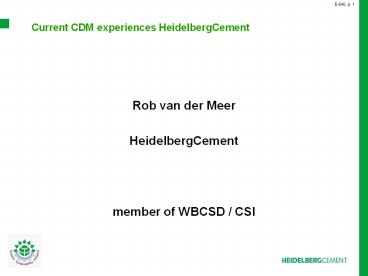Current CDM experiences HeidelbergCement - PowerPoint PPT Presentation
1 / 13
Title:
Current CDM experiences HeidelbergCement
Description:
E-540, p. * Current CDM experiences HeidelbergCement Rob van der Meer HeidelbergCement member of WBCSD / CSI Current CDM experiences HeidelbergCement Potentials in ... – PowerPoint PPT presentation
Number of Views:106
Avg rating:3.0/5.0
Title: Current CDM experiences HeidelbergCement
1
Current CDM experiences HeidelbergCement
E-540, p. 1
- Rob van der Meer
- HeidelbergCement
- member of WBCSD / CSI
2
Current CDM experiences HeidelbergCement
E-540, p. 2
- Potentials in cement industry
- Indocement CDM-project of HeidelbergCement
- Experiences
- Conclusions and recommendations
3
HeidelbergCement
E-540, p. 3
- Turnover 6,9 Billion (2004)
- Producer of
- Cement
- Concrete
- Building materials
- Cement sales gt 65 Million Tons/Year
- 42.000 People
- Active in 52 Countries
- Europe
- Northern America
- Africa / Asia / Turkey
- www.heidelbergcement.de
4
Potentials in cement industry
E-540, p. 4
CO2 emissions at cement production
specific CO2 emissions
Process CO2
Combustion CO2
ca. 0,8 kg CO2 / t Portlandcement
ca. 2/3
ca. 1/3
Raw material
(CaCO3)
Cement mill
Kiln
Cement
Fuels
Additives
o Blast furnace slag
o Limestone
o Puzzolanic materials
5
Potentials in cement industry
E-540, p. 5
- Alternative Fuels
- Rice husk
- Palm oil kernels
- Wood
- Sewage sludge, paper sludge
- Waste tyres
- Waste oil, solvents
- Plastics
- Sorted municipal waste materials
- Clinker substitution
- Blast furnace slag
- Limestone
- Puzzolanic materials
- Fly ash
- Energy efficiency
6
Indocement
E-540, p. 6
Citeureup Factory
CITEUREUP PLANT
CIREBON PLANT
TARJUN PLANT
Total Production Capacity Indocement gt 15
Million Tons/Year
7
Indocement CDM project together with the
Prototype Carbon Fund
E-540, p. 7
- Clinker substitution
- Production of cement with less CO2 emissions by
using alternative materials like limestone, fly
ash and puzzolanic (Trass) materials in cement. - Alternative fuels
- Recovery of waste tyres, rice husk, palm oil
kernels, waste wood materials and later sorted
municipal waste materials (plastics, paper, etc.)
as alternatives for fossil fuels.
8
Expected reduction and tradable CER
E-540, p. 8
- Increase the blend in cement production
- Crediting period 10 years
- Clinker content reduction from 90 to about 83
- Substitute fossil fuel with alternative fuel
- Crediting period max 21, 7 years which may be
renewed at most two times - Substitute 15 fossil fuel
- Contract Indocement and Prototype Carbon
Fund, World bank
9
Indocement CDM project - Status
E-540, p. 9
- PIN
- The Project Idea Note (PIN) forwarded December
2002 together with a Letter of Acceptance of
the Indonesian Environmental Ministry to the
World Bank. - Feasibility studies and Environmental Assessment
Studies finalized at the end of 2003. - PDD
- The Project Design Document (PDD) is written by
Indocement and the World Bank (PCF) together and
submitted to UNFCCCC 23rd. January 2004. - Methodologies
- Begin 2005 the Executive Board of the UNFCCC has
approved the first methodology for the use of
alternative fuels (ACM0003, May 2005) - The approval of the (second) methodology for the
use of blended cement followed in September
(ACM0005, November 2005)
10
Indocement CDM project - Status
E-540, p. 10
- Validation and approval and registration
- Validation by Norske Veritas (DOE) in November
- Written approval by Designated National Authority
(DNA) by end 2005 - Registration
- Formal acceptance by CDM Executive Board (EB)
- Monitoring
- Monitoring according to monitoring plan (part of
the PDD)
11
Experiences
E-540, p. 11
- Procedures
- Indocement initiated the project end of 2002 when
the Project Idea Note (PIN) was sent to
Worldbanks Prototypcarbonfund (PCF). - In 2002 UNFCCCs guidelines were vague.
- Indocement being inexperienced in the field of
CDM required assistance from consultants (to
comply with national legislation, meeting
requirements from Indonesian DNA etc). and the
PCF (Development of two new Methodologies). - Resources and Costs
- Developing costs are too high and definitely a
big hurdle. - financial resources (Indocements costs around
350.000 US for consultants, validations,
registrations etc.) - HR resources (patience required)
12
Conclusions and recommendations
E-540, p. 12
- Procedures
- Lengthy and complicated procedures
- Procedures only understandable for insiders.
- Not stimulating for industrial projects.
- UNFCCC has to strive towards faster and more
efficient procedures - Resources and Costs
- At the moment, CDM is not attractive for
industrial participants. - The procedures for CDM have to be simplified to
make it attractive. - More standardization and guidance is required.
13
E-540, p. 13
- Thank you
- for your attention!































